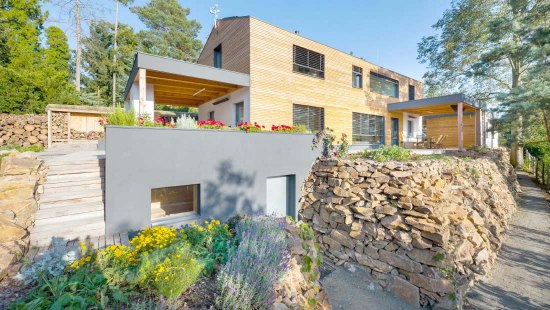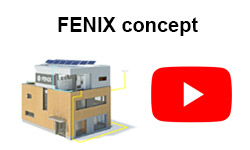Low-energy house in Omice

The house in Omice has been built from the outset as a central part of the CAMEB research project under the auspices of the University Centre for Energy Efficient Buildings at the Czech Technical University in collaboration with manufacturers and suppliers of individual technologies. The aim of the project is to monitor the quality of the environment and at the same time the operating costs of individual technologies in real operation of the house. The data obtained are intended to be used to create an algorithm for the efficient management of the house as a functional whole. Fenix has been involved in the project from the very beginning. The construction of the house took place between 2020 and 2021.
The brick family house is situated on a sloping plot, has a rectangular floor plan of 15.5 x 6 m, and is partially basemented with two above-ground floors. On the southern side of the house, there is an annex with an office, workshop, warehouse, and covered parking space. On the ground floor of the house, there is the main living room with an attached kitchenette, bedroom, bathroom, toilet, technical niche, laundry room, and entrance hall. Upstairs above the living room, there is a gallery, two attic rooms, and a small bathroom with a shower. The house has above-standard equipment in the form of an outdoor pool, whirlpool, sauna, and a wallbox for charging an electric car is installed in the covered parking space. The technical room for the pool, along with storage spaces, is located in the basement of the house.
According to the Building Energy Performance Certificate processed according to Decree No. 78/2013 Coll., the building falls into category B. The thermal loss of the building, calculated with an energetically related area of 163 m² and an outdoor temperature of -15 °C, was determined to be 4.4 kW. The house is permanently inhabited by two people.
Heating
The house is entirely equipped with electric radiant heating. In the ground floor, electric underfloor heating in the form of heating mats LDTS is used under the tiles, and heating foils ECOFILM F are installed under the floating floor in the living room. The bedrooms on the ground floor and attic rooms are equipped with ceiling heating modules ECOFILM MH in suspended ceiling structures. Electric towel radiators are added in the bathrooms for towel drying, a glass radiant panel ECOSUN GS with a handle for towel drying is installed in the kitchen, and outdoor patio heaters ECOSUN TH are used in the outdoor seating area. The total installed power of electric heating is approximately 6.2 kW (including patio heaters 8.7 kW).
However, it should be noted that during the winter months, electric heating is regularly supplemented by a 24 kW wood-burning accumulation fireplace located in the living room. The fireplace alone is capable of comfortably heating the house.
The photovoltaic system
On the roof of the house, there are 30 monocrystalline photovoltaic panels with a power output of 325 Wp each, resulting in a total capacity of 9.8 kWp for the photovoltaic power plant. The panels are divided into two groups of 15 panels each, located on the eastern and western halves of the pitched roof. This distribution ensures higher performance during morning and afternoon hours. The panels are connected to the home battery storage unit, HES, located in the technical room adjacent to the covered parking space. The capacity of the battery storage unit is 41.1 kWh. The HES battery storage unit includes its own asymmetrical 10 kW inverter, MPPT tracker, grid synchronization module, BMS for battery management, control, and communication module, etc. It is a complete hybrid system installed in a cabinet measuring 60x60x192 cm. All household electrical installations are connected through the HES storage unit. Consumption is primarily compensated from the energy stored in the batteries, and in case of increased demand (e.g., heating, electric vehicle charging), some energy is also drawn directly from the distribution grid.
Since February 2022, as part of a pilot project, the operation of the storage system has been tested in the so-called spot price mode - energy management is thus adapted to the current hourly electricity prices on the spot market (more information in a separate article - Purchasing electricity at VOC is also available to households).
In case of low prices, the system can intentionally charge the battery from the grid, while conversely, during high prices, the system aims to supply surplus energy, e.g., profits from PV systems, back to the distribution grid. The battery storage system can actively reduce the average price of electricity, thus significantly contributing to the economy of the entire household operation.
In the fall of 2023, the PV system was supplemented with an additional 5.4 kWp installed on the flat roof of the covered parking space. The current installed capacity is therefore 15.4 kWp.
Control and other technologies
The house is also equipped with a WAFE heat recovery unit providing zonal ventilation of rooms without increasing heat loss. If needed, cooling can be provided in the summer months using a split air conditioning unit, and outdoor blinds also help prevent overheating of the space.
To ensure that all individual technologies function as a single unit, it was necessary to choose a suitable measurement and control system. The choice fell on the Czech product iCOOL4 built on hardware from TECO Kolín. The role of the control system has proven crucial during the operation of the house to ensure optimal environmental quality and efficiency of operating costs. An advantage is the ability to continuously adjust the control system according to current knowledge and requirements without the need to intervene in the hardware part of the regulation. This has gradually allowed the coordination of individual technologies in the house and the creation of a control algorithm that no longer requires significant user intervention. For example, the control system can evaluate current gains from photovoltaic panels, the state of battery charge, and decide whether to start heating the water heater or initiate electric car charging accordingly. The system also provides users with a clear visualization of the status of individual technologies, breakdowns of energy consumption, the ability to create predefined configurations for different situations, etc.
Operating costs
Thanks to the ongoing research project, very detailed information on the partial consumption of individual technologies is available from this house. The following overview provides only the main values for each month.
The heating costs also take into account the use of wood in the fireplace (the amount of burned wood is approximately converted into obtained thermal energy). In comparison to the individual consumption of the house, the relatively high proportion of electric car charging is quite significant. Within low-energy houses, the costs of electric car charging are comparable to or even exceed the previously traditional costs of heating or water heating, making the electric car the largest appliance in the household. With the gradual development of electromobility, the public will need to prepare for this fact.
Since autumn 2021, the homeowner has been with an electricity supplier offering a spot tariff. Monthly electricity billing is available. From March 2022, a test mode of the control algorithm for the HES battery storage depending on spot prices has been initiated. Thanks to this mode, in June 2022, negative invoices were even achieved - meaning the amount and average price of energy supplied to the grid were higher than the amount and average price of energy drawn from the distribution grid. Therefore, the supplier refunded the homeowner the surplus for that month.
| Period | Total electricity consumption (kWh) | PV production (kWh) | Grid consumption (kWh) | Grid feed-in (kWh) | Heating consumption (electricity/wood - kWh) | EV charging (kWh) | Invoice in CZK incl. VAT | Achieved price CZK/kWh |
|---|---|---|---|---|---|---|---|---|
| 02/2022 | 1 253 | 266 | 1 000 | 13 | 237/1 375 | 346 | 4 401 | 3,51 |
| 03/2022 | 1 408 | 582 | 850 | 24 | 248/1 160 | 328 | 6 622 | 4,70 |
| 04/2022 | 1 168 | 724 | 616 | 172 | 176/964 | 320 | 1 912 | 1,63 |
| 05/2022 | 905 | 955 | 343 | 393 | 32/81 | 257 | 237 | 0,26 |
| 06/2022 | 971 | 1 107 | 302 | 438 | 23/0 | 238 | -136 | -0,14 |
| 07/2022 | 1 184 | 1 098 | 466 | 380 | 23/0 | 339 | 1 032 | 0,87 |
| 08/2022 | 896 | 918 | 450 | 472 | 15/0 | 201 | 202 | 0,22 |
| 09/2022 | 823 | 553 | 745 | 475 | 101/135 | 01) | -4752) | -0,57 |
| 10/2022 | 1 605 | 350 | 1 370 | 115 | 215/465 | 593 | 5 688 | 3,54 |
| 11/2022 | 1 564 | 147 | 1 615 | 198 | 277/662 | 535 | 6 552 | 4,18 |
| 12/2022 | 1 868 | 72 | 2 035 | 239 | 499/1445 | 653 | 10 070 | 5,40 |
| Total | 13 645 | 6 772 | 9 792 | 2 919 | 1 846/7 349 | 3 900 | 36 105 | 2,64 |
1) In September 2022, the electric vehicle was intentionally not charged.
2) In the invoice for September 2022, the state subsidy was deducted by the supplier as an advance payment in the amount of 2000 CZK in accordance with Government Regulation No. 262/2022 Coll. (so-called Savings Tariff).
| Period | Total electricity consumption (kWh) | PV production (kWh) | Grid consumption (kWh) | Grid feed-in (kWh) | Heating consumption (electricity/wood - kWh) | EV charging (kWh) | Invoice in CZK incl. VAT | Achieved price CZK/kWh |
|---|---|---|---|---|---|---|---|---|
| 01/2023 | 1 852 | 114 | 1 754 | 17 | 519/1 472 | 612 | 7 353 | 3,97 |
| 02/2023 | 1 673 | 262 | 1 414 | 3 | 482/1 443 | 504 | 6 667 | 3,98 |
| 03/2023 | 1 626 | 562 | 1 146 | 82 | 402/1 135 | 501 | 4 502 | 2,76 |
| 04/2023 | 1 510 | 660 | 1 278 | 428 | 214/759 | 579 | 3 4403) | 2,27 |
| 05/2023 | 1 103 | 1 072 | 597 | 566 | 72/240 | 332 | 1 166 | 1,05 |
| 06/2023 | 973 | 1 024 | 548 | 599 | 19/0 | 323 | 850 | 0,87 |
| 07/2023 | 1 245 | 1 143 | 692 | 590 | 12/0 | 396 | 1 003 | 0,80 |
| 08/2023 | 965 | 797 | 634 | 466 | 19/0 | 277 | 1 118 | 1,15 |
| 09/2023 | 853 | 646 | 584 | 377 | 7/0 | 273 | 2 419 | 2,83 |
| 10/2023 | 1 265 | 332 | 1 074 | 141 | 158/316 | 508 | 3 468 | 2,74 |
| 11/2023 | 1 501 | 2554) | 1 396 | 150 | 307/475 | 503 | 4 199 | 2,80 |
| 12/2023 | 1 746 | 94 | 1 672 | 20 | 404/618 | 534 | 4 789 | 2,74 |
| Total | 16 312 | 6 961 | 12 789 | 3 439 | 2 615/6 458 | 5 342 | 40 974 | 2,51 |
3) Since April 2023, there has been a change in the supplier for both purchase and sale on the spot market.
4) Since October 2023, the PV system has been supplemented by an additional 5.1 kWp.
| Period | Total electricity consumption (kWh) | PV production (kWh) | Grid consumption (kWh) | Grid feed-in (kWh) | Heating consumption (electricity/wood - kWh) | EV charging (kWh) | Invoice in CZK incl. VAT | Achieved price CZK/kWh |
|---|---|---|---|---|---|---|---|---|
| 01/2024 | 1 768 | 200 | 1 581 | 13 | 382 / 250 | 647 | 4 962 | 1,10 |
| 02/2024 | 1 365 | 379 | 1 041 | 55 | 225 / 263 | 555 | 2 509 | 1,83 |
| 03/2024 | 1 624 | 834 | 1 068 | 278 | 222 / 174 | 613 | 1 918 | 1,18 |
| 04/2024 | 1 347 | 1 142 | 742 | 537 | 117 / 113 | 436 | 1 690 | 1,25 |
| 05/2024 | 1 563 | 1 358 | 827 | 614 | 35 / 0 | 439 | 1 268 | 0,81 |
| 06/2024 | 1 308 | 1 580 | 492 | 764 | 25 / 0 | 436 | 452 | 0,34 |
| 07/2024 | 1 676 | 1 531 | 807 | 662 | 6 / 0 | 463 | 1 223 | 0,73 |
| 08/2024 | 1 292 | 1 198 | 766 | 672 | 2 / 0 | 5875) | 993 | 0,77 |
| 09/2024 | 1 705 | 790 | 1 180 | 265 | 0 / 0 | 929 | 3 250 | 1,90 |
| 10/2024 | 1 555 | 440 | 1 338 | 223 | 180 / 124 | 730 | 2 060 | 1,32 |
| 11/2024 | 1 969 | 263 | 1 730 | 24 | 295 / 486 | 503 | 9 487 | 4,82 |
| 12/2024 | 2 131 | 139 | 2 021 | 29 | 449 / 581 | 781 | 10 680 | 5,01 |
| Total | 19 303 | 9 854 | 13 585 | 4 136 | 1 938 / 1 991 | 7 119 | 40 492 | 2,10 |
5) A second electric car was purchased in August 2024
Detailed data on energy consumption for heating are no longer available for the year 2025.
| Period | Total electricity consumption (kWh) | PV production (kWh) | Grid consumption (kWh) | Grid feed-in (kWh) | EV charging (kWh) | Invoice in CZK incl. VAT | Achieved price CZK/kWh |
|---|---|---|---|---|---|---|---|
| 01/2025 | 2 152 | 166 | 2 052 | 66 | 532 | 9 769 | 4,54 |
| 02/2025 | 1 773 | 427 | 1 491 | 145 | 479 | 7 960 | 4,49 |
| 03/2025 | 2 010 | 900 | 1 331 | 221 | 760 | 4 248 | 2,11 |
| 04/2025 | 1 632 | 1 077 | 965 | 410 | 625 | 1 456 | 0,89 |
| 05/2025 | 1 436 | 1 182 | 870 | 616 | 545 | 880 | 0,62 |
| 06/2025 | 1 452 | 1 355 | 820 | 723 | 537 | 826 | 0,57 |
| 07/2025 | - | - | - | - | - | - | - |
| 08/2025 | - | - | - | - | - | - | - |
| 09/2025 | - | - | - | - | - | - | - |
| 10/2025 | - | - | - | - | - | - | - |
| 11/2025 | - | - | - | - | - | - | - |
| 12/2025 | - | - | - | - | - | - | - |
| Total | 10 455 | 5 107 | 7 529 | 2 181 | 3 478 | 25 139 | 2,40 |
Previews of individual monthly invoices can be provided to interested parties upon request.
The family house in Omice is an example of a modern, fully electrified building in which the choice of suitable technologies, and especially their functional integration and management, contribute to very interesting operating costs without negatively impacting user comfort.









